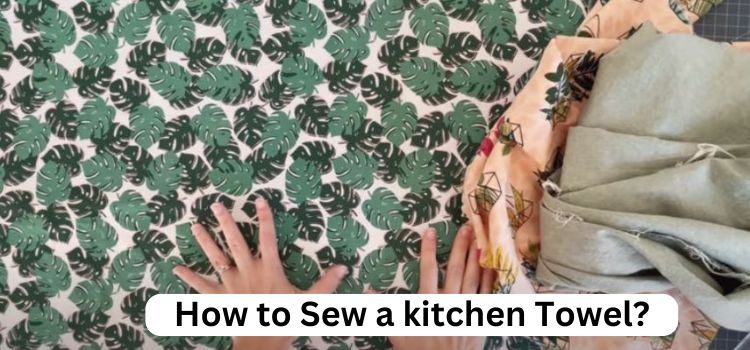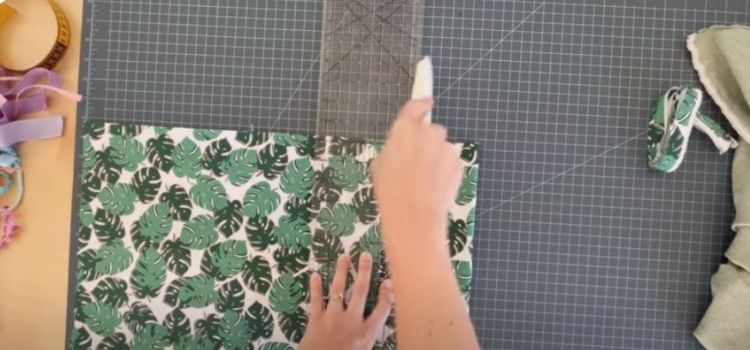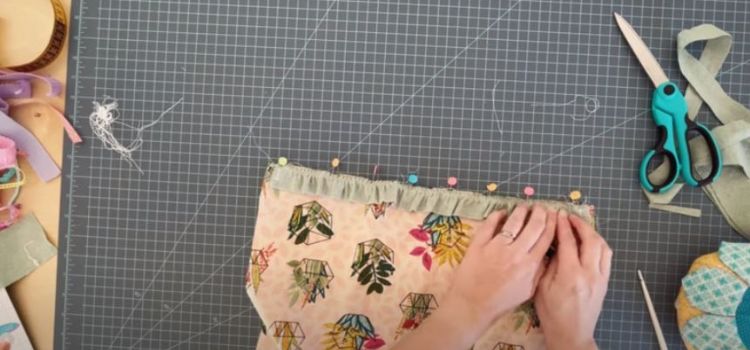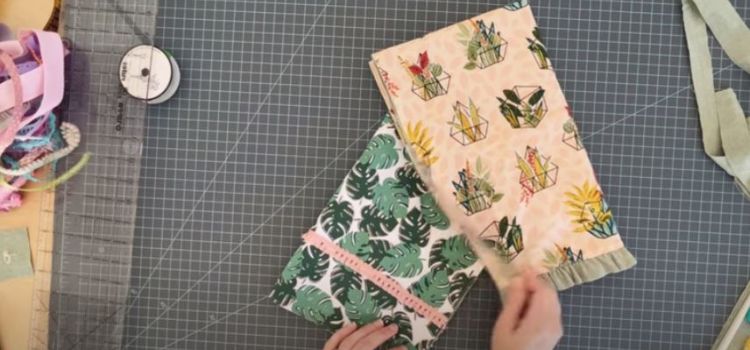
Introduction
Sewing a kitchen towel can be a fun and practical DIY project for anyone looking to add a personal touch to their kitchen. This article will discuss the step-by-step process of sewing a kitchen towel, including the materials you will need and the sewing techniques involved. Whether you are a beginner or an experienced sewer, this guide will help you create a custom kitchen towel that is both functional and stylish. So, let’s get started and learn how to sew a kitchen towel!
Gather Materials and Tools needed for Sewing
Materials:
- 1 yard of fabric (cotton is a good choice for kitchen towels)
- Matching thread
- Sewing machine
- Scissors
- Pins
- Measuring tape
- Iron and ironing board
- Fabric pencil or chalk
Optional:
- Rotary cutter and cutting mat
- Serger
You can start sewing your kitchen towel once you gather these materials and tools.
Measure and Cut Fabric to the Desired Size

To measure and cut fabric for a kitchen towel, decide on the desired size. Use a measuring tape to measure the dimensions of the fabric, marking the measurements with a fabric pen or chalk. Once the fabric is marked, use fabric scissors to carefully cut along the marked lines to create the desired size for the kitchen towel. Be sure to cut straight and even lines to ensure a neat finish for the towel.
Hem the Edges of the Fabric
Hemming the edges of a fabric kitchen towel is a simple and valuable skill. Not only does it give your towel a professional and finished look, but it also helps to prevent fraying and increases its durability. Whether you’re a beginner or an experienced seamstress, hemming the edges of a kitchen towel is a quick and easy project that can be completed in just a few steps.
- Cut your fabric to the desired size for your kitchen towel. Leave a little extra fabric on each side to account for the hem.
- Fold over one edge of the fabric about 1/4 inch and press with an iron. Then fold over that edge another 1/4 inch and press again. This will result in a tidy and spotless hem.
- Pin the folded edge in place to secure it while you sew. Repeat this process for all four sides of the kitchen towel.
- Set up your sewing machine with the matching thread and select a straight stitch. Sew along the folded edge of the fabric, removing the pins as you go. Make sure to backstitch each side’s beginning and end to secure the hem in place.
- Once you have sewn all four sides, trim any excess thread and give your kitchen towel a final press with an iron to set the hem.
Add any Decorative Elements.
Are you looking to add some personality and style to your kitchen towels? Adding a decorative element can elevate the look of your kitchen and make even the most mundane task of drying dishes more enjoyable. Here are some creative ideas to add a decorative touch to your kitchen towels:
Embroidery: Embroidery is a classic way to add a personal touch to your kitchen towels. You can embroider your initials, a cute design, or a fun quote to make your towels unique and special.
Pom-Pom Trim: Sewing on colorful pom-pom trim can add a playful and whimsical touch to your kitchen towels. Choose pom-poms in a contrasting color to make a bold statement, or opt for neutral tones for a more subtle look.
Applique: Applique is another fun way to add a decorative element to your kitchen towels. Cut out fabric shapes like fruits, animals, or flowers and attach them to your towels with fabric glue or by sewing them on for a personalized touch.
Fabric Paint: Fabric paint is a great way to add color and design to your kitchen towels. You can use stencils, stamps, or freehand painting to create unique patterns and designs that reflect your style.
Tassel Trim: Adding tassel trim to the edges of your kitchen towels can give them a boho-chic look. You can purchase pre-made tassel trim or make your own using yarn or embroidery floss in coordinating colors.
Ribbon: Sewing on a decorative ribbon along the edges of your kitchen towels can instantly elevate their appearance. Choose a ribbon with a fun pattern or color that complements your kitchen decor.
Fabric Applique: Cut shapes from colorful fabric and sew them onto your kitchen towels for a vibrant and artistic touch. You can create geometric patterns, floral designs, or abstract shapes for a one-of-a-kind look.
Sew a Loop for Hanging the Towel

Regarding towels, having a loop for hanging can be incredibly convenient. Whether hanging your towel in the bathroom, kitchen, or even by the pool, a loop makes it easy to keep it handy and organized. Sewing a loop for hanging a towel is a simple and valuable skill anyone can learn.
Here’s a step-by-step guide to sewing a loop for hanging a towel:
- Cut your fabric loop to the desired length. Typically, a loop of around 4-6 inches works well for a towel.
- Fold the fabric loop in half and pin the ends together.
- Place the loop on the edge of the towel where you want it to hang. Leave a little space between the loop and the edge of the towel to allow for Sewing.
- Using a sewing machine or needle and thread, sew a straight stitch along the pinned edge of the loop, attaching it securely to the towel.
5. For extra durability, you can sew a few additional stitches at the top and bottom of the loop.
- Trim any excess thread and fabric, and your towel loop is ready to use.
Wash and use the finished kitchen towel

Kitchen towels are a staple in any kitchen, from drying dishes to wiping up spills. However, it’s important to properly wash and care for your kitchen towels to ensure they stay clean and hygienic. Here are some tips on how to wash and use your finished kitchen towel.
- Wash Before Use: Before using your kitchen towel for the first time, it’s important to wash it well. This will remove any dirt or chemicals that may be present in the manufacturing process. Toss the towel in the washing machine with a mild detergent and wash on a gentle cycle.
- Use Separate Towels for Different Tasks: It’s a good idea to have separate towels for different tasks in the kitchen. For example, have one towel specifically for drying dishes and another for wiping down countertops. This will help prevent cross-contamination and keep your towels clean.
- Wash Regularly: Kitchen towels can quickly become a breeding ground for bacteria if not washed regularly. It’s recommended to wash your kitchen towels at least once a week or more frequently if they become heavily soiled. Use hot water and a good laundry detergent to kill germs and remove stains.
- Avoid Fabric Softener: Fabric softener can leave a residue on your kitchen towels, making them less absorbent. Avoid using fabric softener when washing your towels, and opt for a vinegar rinse instead to help remove any build-up.
- Hang to Dry: After washing your kitchen towel, it’s best to hang it to dry rather than put it in the dryer. This will help prevent shrinkage and prolong the life of your towel. Hang it on a drying rack or towel bar until completely dry.
FAQs
What fabric should you use to make kitchen towels?
Cotton is the best fabric for making kitchen towels. It is absorbent, durable, and easy to clean, making it perfect for the kitchen.
What distinguishes a kitchen towel from a dish towel?
A dish towel is typically used for drying dishes and utensils, while a kitchen towel is more general-purpose and can be used for a variety of tasks in the kitchen, such as wiping up spills or handling hot pots and pans.
How do you tie a kitchen towel?
To tie a kitchen towel, fold it in half lengthwise and wrap it around your waist. Tie the ends together in a knot at the front or back to secure the towel. This can help keep the towel from falling off while cooking or working in the kitchen.
Final Words
In conclusion, sewing a kitchen towel is a simple and practical project that beginners and experienced sewers can easily accomplish. Following a few basic steps and using suitable materials, you can create a custom kitchen towel to add a personal touch to your home. Whether you’re looking to save money, reduce waste, or enjoy the satisfaction of creating something with your hands, sewing a kitchen towel is a rewarding and enjoyable activity. With some practice and creativity, you can create beautiful and functional kitchen towels to enhance your home and make great gifts for friends and family.
